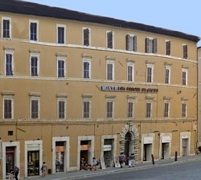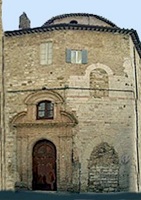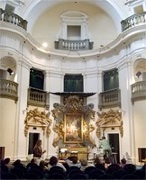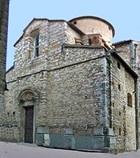Pietro Baglioni (1629-1705)
Pietro Baglioni belonged to a branch of the Baglioni family: the main line of the family became extinct in 1648, on the death of Bishop Malatesta V Baglioni. He travelled widely as a young man and had extensive cultural interests. He is best remembered as an architect.
Perugia
Palazzo Baglioni (late 17th century)

Pietro Baglioni designed Palazzo Baglioni (in Via Riario, now 14-30 Via Baglioni) as a town house for his relative, Count Guido Baglioni. The palace now houses the Monte dei Paschi di Siena.
[Pietro Baglioni also designed the chapel of the villa of Guido Baglioni at Palazzone, outside Perugia (the site of an Etruscan necropolis).]
Oratorio di Santa Cecilia (1687-90)


The Oratorian Fathers of San Filippo Neri built the Oratorio di Santa Cecilia on land near their church that they acquired from Andrea Sciri. It was purpose-built for musical devotion, to a design by Pietro Baglioni, and dedicated it to St Cecilia, the patron saint of music.
The oratory was used extensively for musical performances throughout the 18th century, but subsequently fell into disuse. The building was used as a cinema in the mid-20th century, but has subsequently been restored. It is now used as an auditorium.
Alessandro Baglioni (died after 1734)
Alessandro, the son of Pietro Baglioni, studied in Rome. Like his father, he had extensive cultural interests, but is best remembered as an architect. He was the director of the Accademia del Disegno, Perugia from 1734.
Perugia
Santa Teresa (1718)

Teatrino del Leon d’ Oro (1717-23)
Alessandro Baglioni designed this theatre, but it soon proved to be too small. In 1765, the Accademici del Casino commissioned Pietro Carattoli to design a more imposing structure, Teatro del Pavone, to replace it.
Return to Art in: Perugia.



